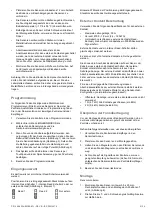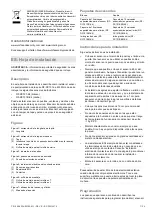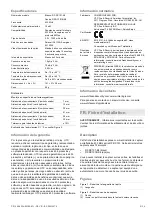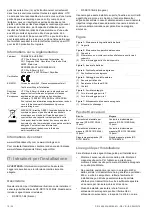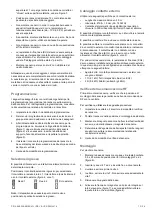
2 / 26
P/N 466-5226-EMEA-
ML • REV B • ISS 09MAY16
EN: Installation Sheet
WARNING:
Important safety information. Read enclosed
warnings and safety information.
Description
This installation sheet describes how to install RF-DC101
Series 433 MHz Door/Window Sensor. The series include the
following wireless sensors:
•
RF-DC101-K4 (white)
•
RF-DC101B-K4 (mahogany)
You can install the sensor on doors, windows, and other
objects that open and close. The sensor transmits signals to
the control panel when a magnet mounted near the sensor is
moved away from or closer to the sensor. The sensor is
equipped with a wall and cover tamper for additional security.
Figures
Figure 1: Removing the battery pull tab
(1) Pull tab
Figure 2: Removing the sensor cover
(1) Cover
(2) Press small screwdriver into slot and lift cover
(3) Cover screw mounting hole
Figure 3: Inserting the battery
Figure 4: Input selection jumper
(1) Input selection jumper
Figure 5: External contact wiring
(1) Door/Window Sensor
(2) EOL resistor
(3) Contacts
Figure 6: Mounting holes
(T) Mounting hole for T screw
(L) Mounting hole for L screw
Figure 7: Sensor and magnet alignment
(1) Align marks
Accessory packs
White
Mahogany
10-pack spacer housing for
sensor (RF-DC101SR-K4)
10-pack spacer housing for sensor
(RF-DC101BSR-K4)
10-pack spacer housing for
magnet (RF-DC101SM-K4)
10-pack spacer housing for
magnet (RF-DC101BSM-K4)
Single large magnet (RF-
DC101BM-K4)
Single large magnet (RF-
DC101BBM-K4)
Installation guidelines
Use the following installation guidelines:
•
Mount the sensor on the door frame. Mount the magnet on
the door. If the sensor is used on double doors, mount the
sensor on the least-used door and mount the magnet on
the most-used door.
•
If possible, locate sensors within 60 m of the panel.
A transmitter may have a range of 600 m or more out in
the open, but the environment at the installation site can
have a significant effect on transmitter range. Sometimes
a change in sensor location can help overcome adverse
wireless conditions.
•
When mounting, make sure the alignment arrow on the
magnet points to the alignment mark on the sensor, and
the gap between them is not bigger than 1 cm to ensure a
pro
per “closed” condition on metal surfaces. See Figure 7.
•
Place sensors at least 12 cm above the floor to avoid
damaging them.
•
Avoid mounting sensors in areas where they will be
exposed to moisture or where the sensor operating
temperature range of
−10 to 55°C will be exceeded.
•
Mount directly to a stud if possible. If a stud is not
available, use wall anchors.
•
Avoid mounting the sensor in areas with a large quantity of
metal or electrical wiring.
•
End-of-line (EOL) resistors must always be connected to
the external contact terminals if the external contact is
being used. See
“External contact wiring” on page 3 for
proper wiring details.
•
Mount sensors with screws, not double-sided tape.
Caution:
You must be free of static electricity when handling
electronic components. Touch a grounded bare metal surface
before touching a circuit board or wear a grounded wrist strap.
Programming
The following steps describe general guidelines for
programming (learning) the sensor in to panel memory. Refer
to the specific panel and/or receiver’s documentation for
complete programming details.
1. Set the panel to program mode.
2. At the LEARN SENSORS menu, select the appropriate
sensor group and sensor number assignments.
3. When prompted by the panel to trip the sensor for
learning, remove the battery pull tab (Figure 1) or remove
the sensor cover (Figure 2) and if required insert the
battery into the holder, observing correct polarity
(Figure 3).
4. The system should acknowledge learning the sensor by
touchpad display and/or audio (depending on the panel).
5. Exit program mode.
Input selection
Only one internal reed switch can be used at any given time.
Position the input selection jumper to select internal reed
switch 1, internal reed switch 2, or external contact only
(Figure 4, item 1).
Reed 1
Reed 2
External only





